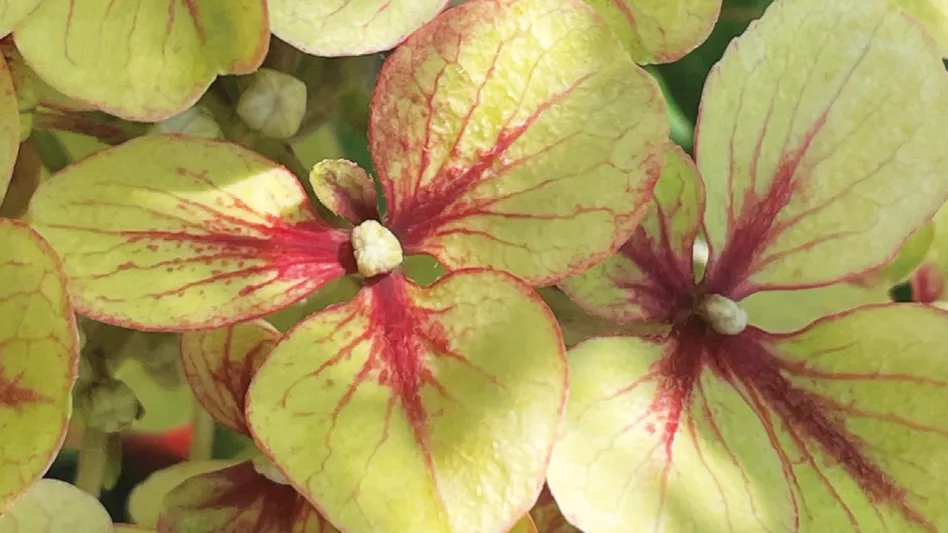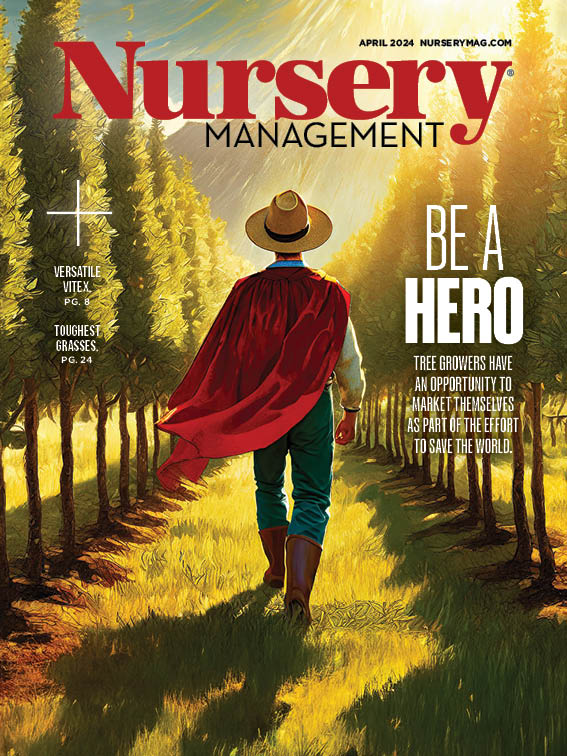
Photos provided by Murray buckner
My name is Murray Buckner, and I have a tiny company Full Moon Blooms in Virginia. Everyone says there are too many similar Hydrangea paniculatas on the market now and new ones coming almost daily. It is a popular plant and so every grower/distributor wants to capitalize on it. ‘Limelight’ changed the paniculata market over twenty years ago and since then there have been only incremental changes in size, coloring and habit. I’m hoping to change that.
I have a background in architecture and landscape architecture but have lived and breathed Hydrangea paniculata for the last fifteen years. It started with a Limelight shrub that was damaged in a summer storm and a florist that said he would buy the flowers from my eight plants. The journey to become a paniculata flower farmer was born from that experience with the florist but also an impetuous decision to leap into flower farming, although ignorant of what is involved to be a successful flower farmer. It turns out there is more to farming than producing a crop, especially focusing on just one plant, Hydrangea paniculata. If I could have made alcohol out of it, things would have been much easier.
“Chasing the Blues” is the story of my evolution from being a H. paniculata flower farmer to also becoming a H. paniculata breeder trying to produce the first blue paniculata or Interspecific hybrid. Perhaps it will be published one day or even made into a Netflix miniseries. Lots of intrigue with good and bad characters, smuggling, millionaires, billionaires, as well as opportunists that come out of the woodwork and lastly the mandatory high-priced lawyers who are experts in IP, patents and trademarks.
Mop head paniculata?
The short version of my story is that to sell more paniculatas I decided that I should make a paniculata that looked like a macrophylla mop head. I achieved that goal fairly quickly but I couldn’t sell it as a cut flower. I realized that once it was on the market everyone could just root their wedding bouquet so I decided to keep it just for breeding purposes.
A quick diversion – which brings up whether the goal of trying to achieve a mop head form of paniculata flower was actually a good idea. The mop head flower form consists of a high ratio of showy sepals to the much smaller fertile flowers. I have hybridized several cultivars that have almost no fertile flowers with very dense flower heads. They are difficult to hybridize further.
Consumers obviously like the mop head form but is it healthy for the environment?
While not native to the U.S. or Europe, the open paniculatas such as ‘Quickfire’ offer insects food and shelter. Mop head hydrangeas offer much less food. I hope people will buy the open flowering paniculatas for the unique paniculata form and to help the insects that are experiencing a population collapse. Fortunately, florists are ordering many more of these for their looser form.

I am not a horticulturist nor a biologist, botanist, geneticist or chemist but I do have enough knowledge of the fields to make me dangerous and I have gotten help from chance inquiries and opportune circumstances. Dr. William Kelso, the famed archeologist who found the original site of Jamestown, told me that he found the fort with the first shovel he put in the ground. I asked him how he did that and he told me it was in the historical records he researched.
That knowledge stuck with me. I am also persistent. So to achieve the blue paniculata, I read almost every scientific article concerning breeding Interspecific Hydrangeas and the science behind hydrangea coloration. Existing research led me to believe I could possibly create a blue interspecific hybrid by crossing a Hydrangea paniculata and a Hydrangea macrophylla and then using embryo rescue. But unfortunately, the seeds self-fertilized, not cross-pollinated – something the research said couldn’t happen.
I talked to some of the original scientists that tried to achieve this. Eventually this search led me to Dr. Henry Schreiber who has written extensively about the color in hydrangeas and actually created a yellow hydrangea. He helped me a lot.
Why paniculata
With a warming planet, I believe H. paniculata is the hydrangea species to grow for the future. It’s hardy, tough and always blooms. You can manipulate the bloom time, flower shape and size as well as the plant shape and size. The only thing missing has been the more ornamental flowers of the macrophyllas. My advice to anyone in the breeding world or in general is the “importance of educated observation” which is having enough knowledge of what you’re observing that you can recognize what makes it important, valuable, unique and something to learn from.
To this end, I have bred paniculatas that are as showy as any macrophylla. I believe they will change the hydrangea landscape but also the hydrangea cut flower market worldwide.
I grow a lot of seedlings each year. There may be only a few companies that grow more. For obvious reasons I can’t go into great detail of what I have developed but I can tell you of some unique traits.
I have plants that are dwarf and giants. I have tight mops and loose flower forms but all of them start blooming with color. There are plants with five to seven leafed whorled phylotaxy as well as whorled sepals. Some have unique leaf color. In my chase for the blue paniculata I was amazed that I got plants that have color never seen before in any species of hydrangea. That is why many of us hybridizers spend countless hours laboring over our plants; the magic of something wonderous. I hope this is my legacy. It’s something I am proud of.
I want to thank Michael Dirr for his never-ending encouragement as well as his extensive knowledge of plants and hydrangeas in particular. I also want to thank Dr. Henry Schreiber and all the breeders that came before me. Lastly, I want to thank all the generous people that have supported me throughout this adventure financially and through encouragement.

Explore the April 2024 Issue
Check out more from this issue and find you next story to read.
Latest from Nursery Management
- GardenComm 2024 Annual Conference registration is open
- Landmark Plastic celebrates 40 years
- CropLife applauds introduction of Miscellaneous Tariff Bill
- Greenhouse 101 starts June 3
- Proven Winners introduces more than 100 new varieties for 2025
- CIOPORA appoints Micaela Filippo as vice secretary-general
- Rock Star Roses
- The container challenge





